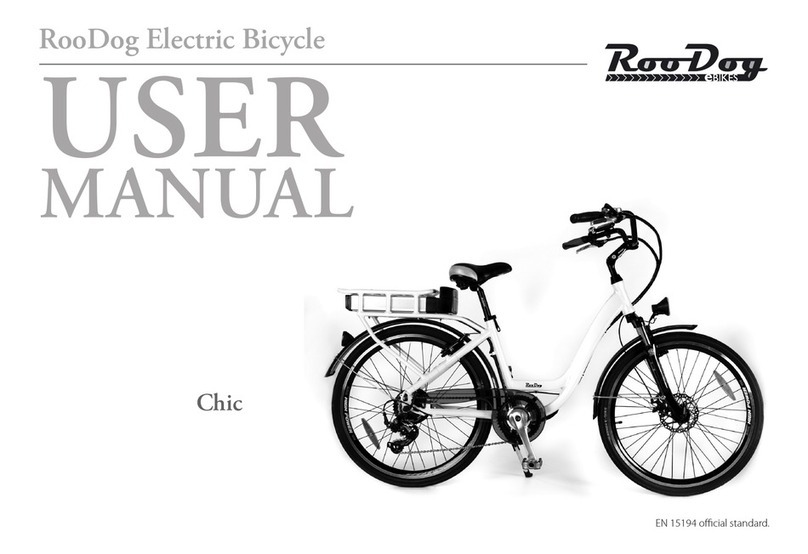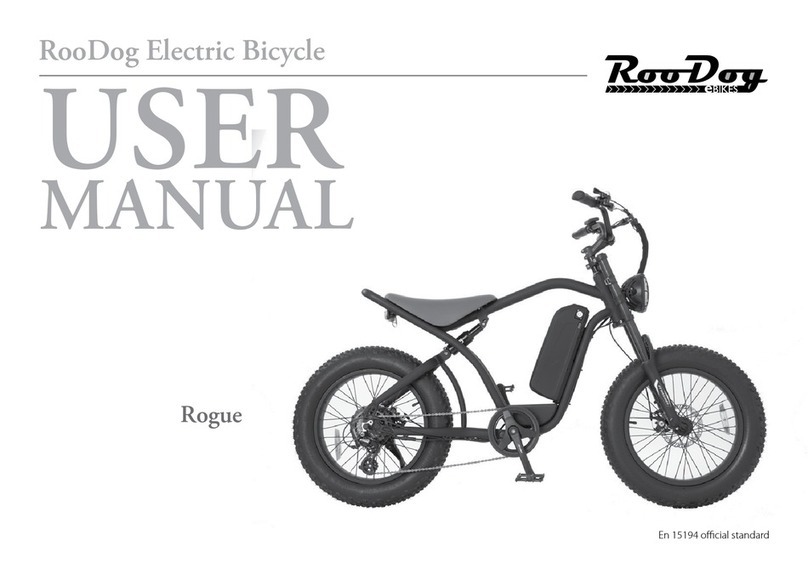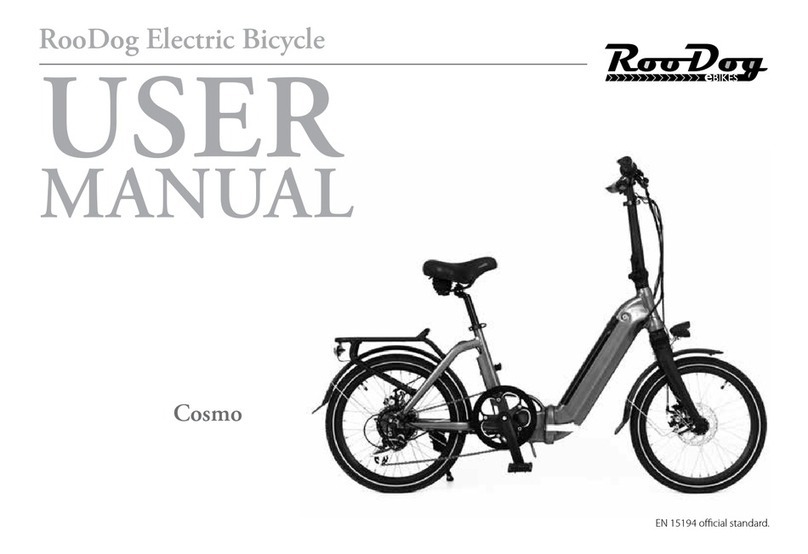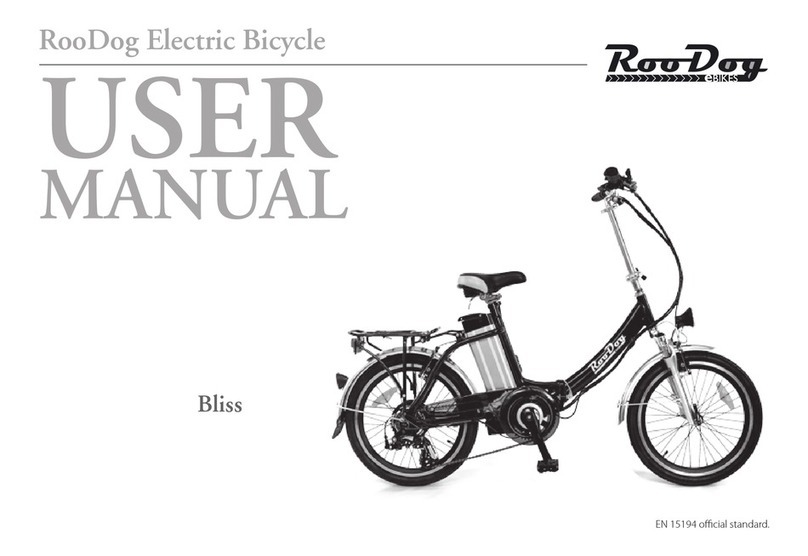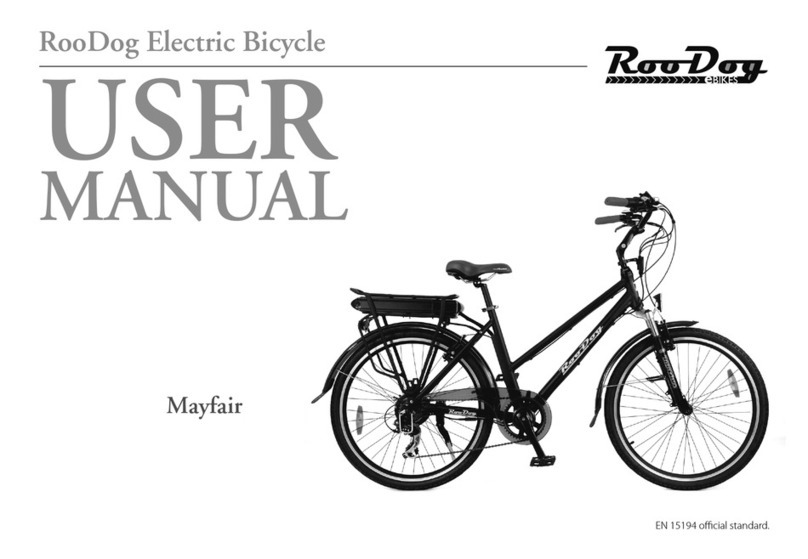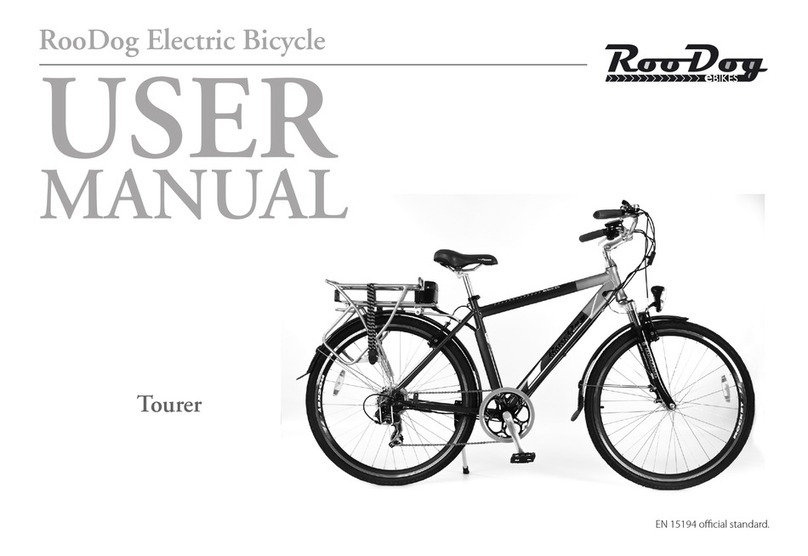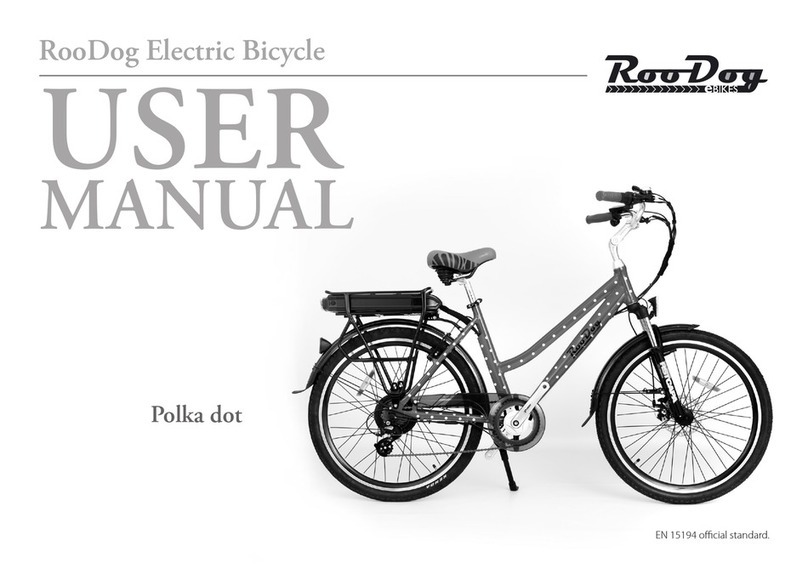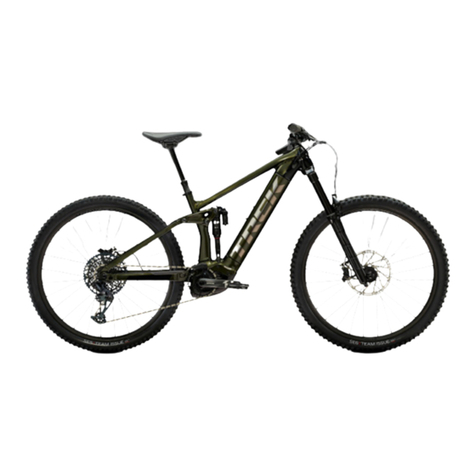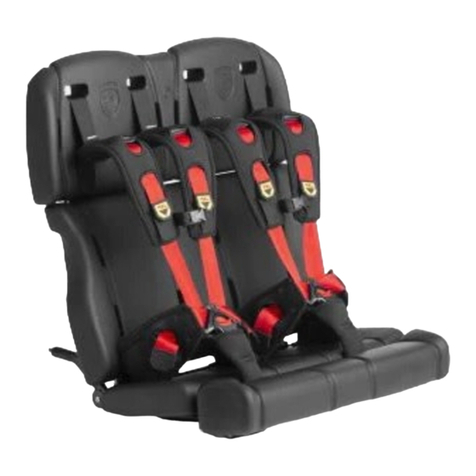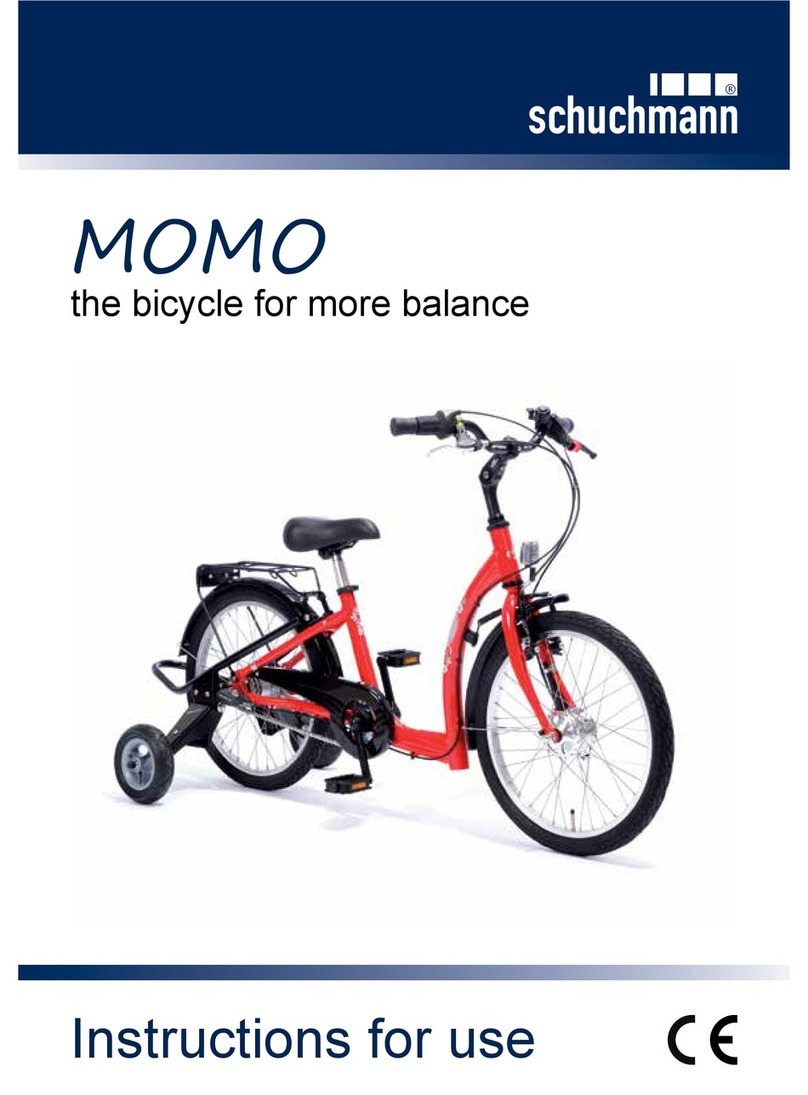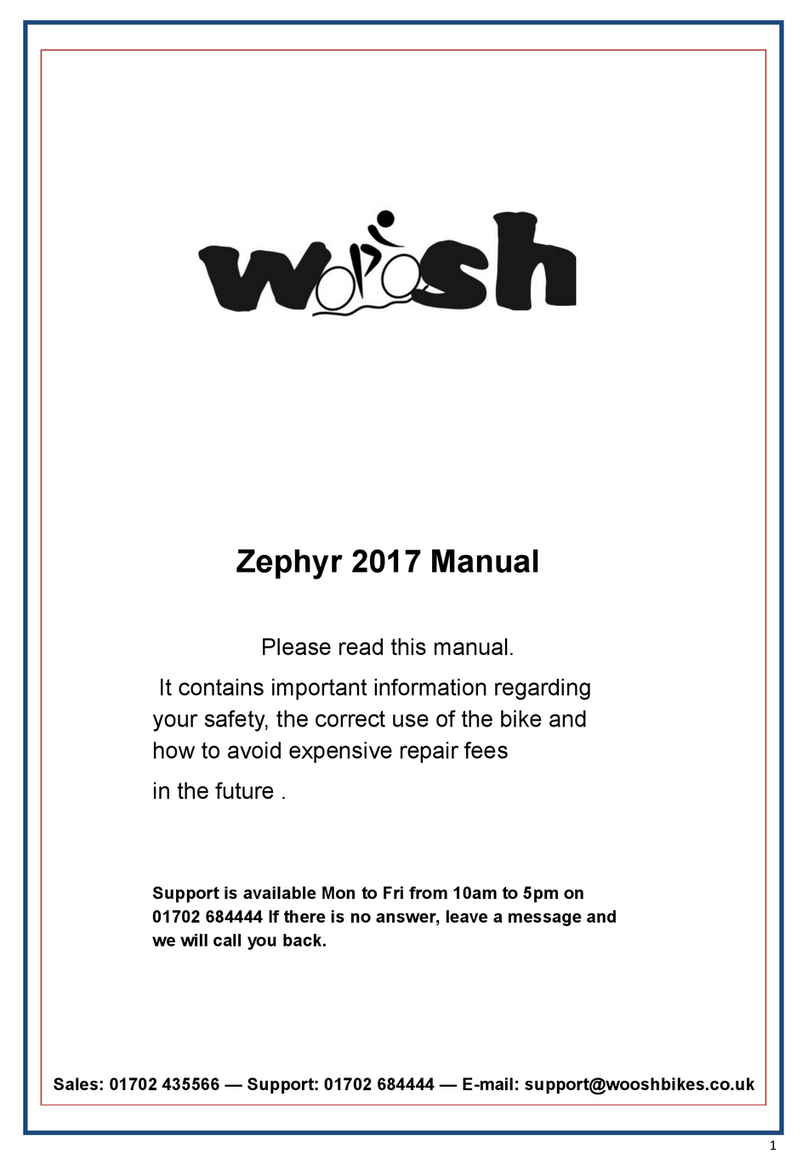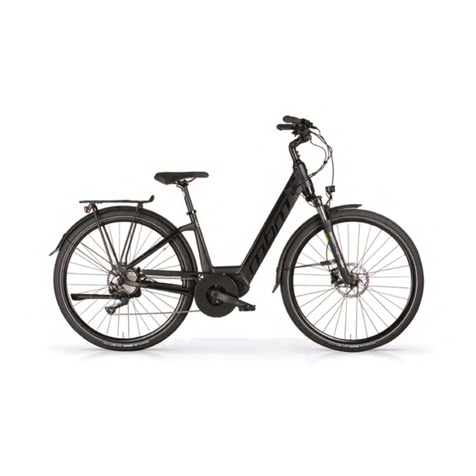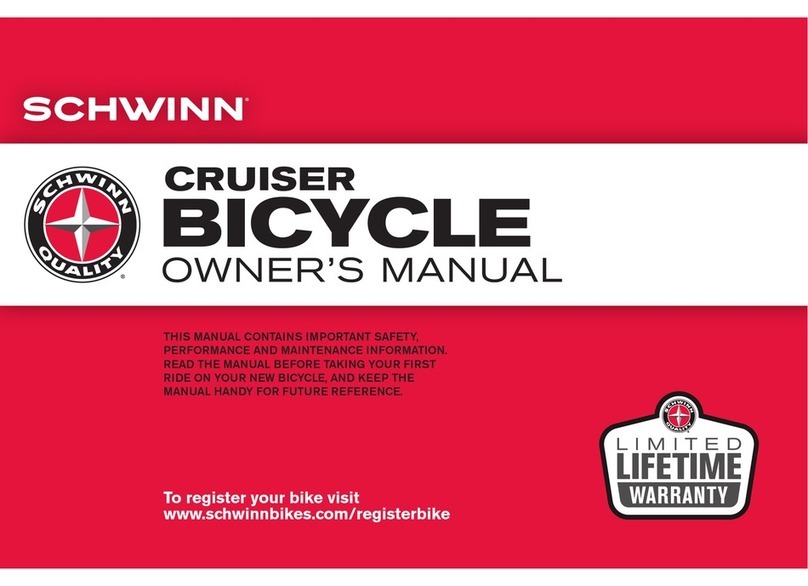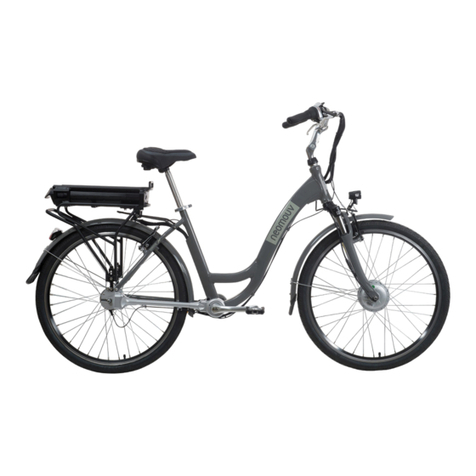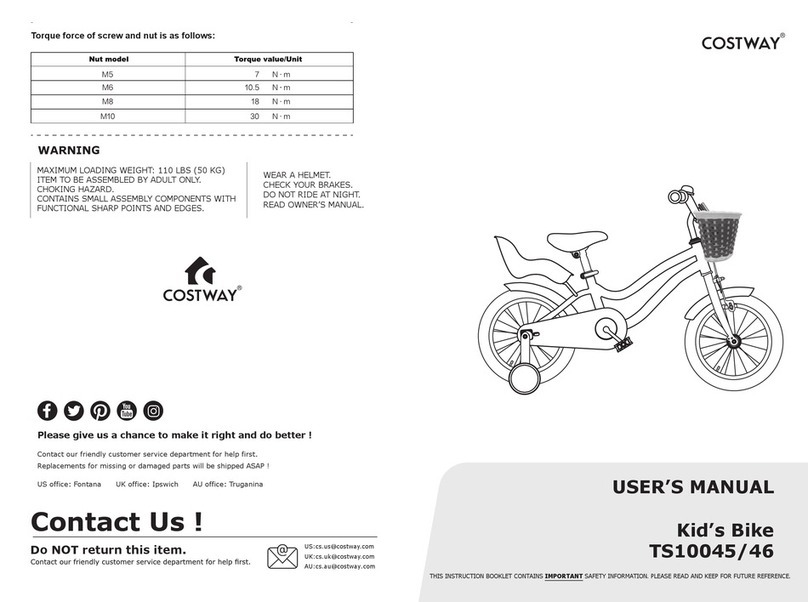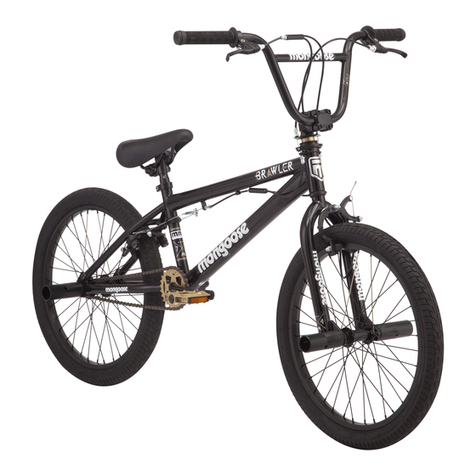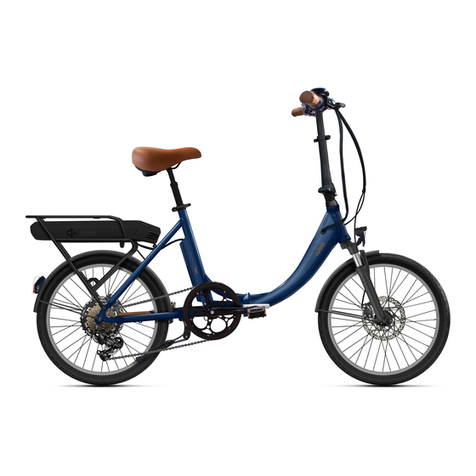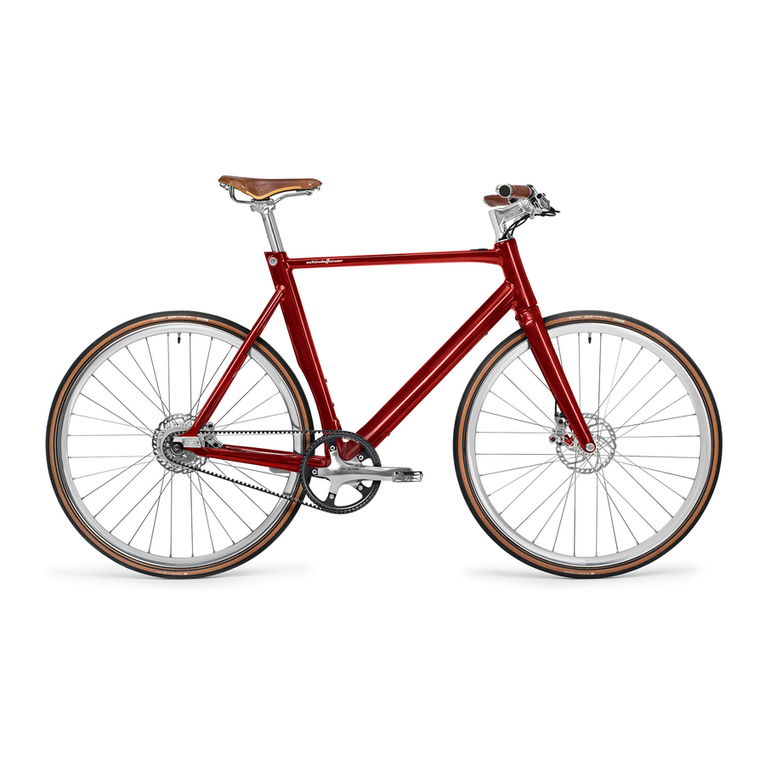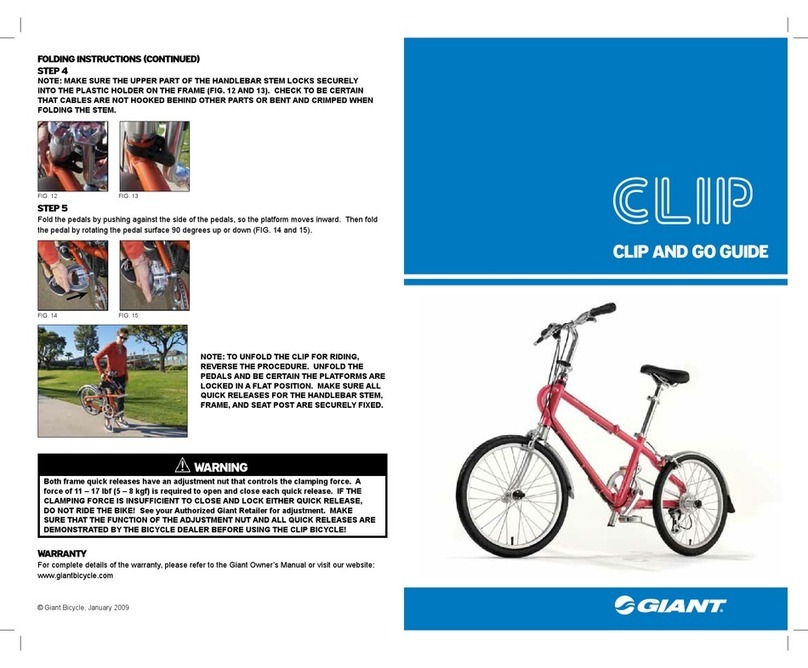RooDog Tourer User manual

RooDog Electric Bicycle
USER
MANUAL
En 15194 official standard
Tourer

www.roodog.co.uk |32 |www.roodog.co.uk
Contents
1 x Electric bike, 1 x Battery, 1 x Charger, 1 x User Manual and 1x Battery Care Manual
Index
Parts I.D ......................................................................................................................................................6
Bike assembly......................................................................................................................................... 7
Getting started & how to use power assistance .............................................................. 8
LCD Display - Display Interface.........................................................................................10-11
Battery Charging & Removal ..................................................................................................... 12
Maintenance ................................................................................................................................13-14
General Specifications............................................................................................................15-16
Warranty................................................................................................................................................. 17
Troubleshooting.........................................................................................................................18-19

www.roodog.co.uk |54 |www.roodog.co.uk
Thank you for buying a RooDog electric bike. We believe that this is one of the best purchases you will ever make providing it is cared
for properly.
Important: Please read this manual carefully before use and follow instructions provided at all times.
For your own safety check brakes, gears, lights and tyre pressures are fully operational and correct before any bike ride. Also check all
fasteners, quick release bolts and anything else that may be of hazard prior to setting off.
Important:
Please read and follow battery care guidelines in this booklet before first use.
Warnings:
• Users who are not professionally trained for bicycle assembly or mechanics should not attempt to install, disassemble, or
modify components. If you have any concerns about the operation of the Pedal Assist System (PAS) or its components, or you
suspect damage to the battery, visit your local RooDog stockist immediately for inspection.
• Do not attempt to modify the PAS or throttle systems. The PAS is set to provide riding support in line with UK regulations (up
to 15.5mph with 250w motor and 4mph for the throttle).
Riding Safety
• Make sure you are familiar with your ebike before riding it on public roads or footpaths.
• Do not focus on the display console while riding.
• Please note that riding with the PAS turned off is the same as riding a normal bike.
• When switched on the PAS will start to engage as soon as you start pedalling.
• Riders should be seated on the bike with at least one brake ready to engage before pedalling begins.
• Do not start on the fastest setting – start on the lowest setting for your first few rides.
Please note: Bike images shown in this manual may differ from your RooDog ebike however, all information provided is
applicable to your RooDog.
Identity:
Serial number:
Dealer stamp: Date purchased: / /

www.roodog.co.uk |76 |www.roodog.co.uk
Parts I.D
We continually strive to give the best products
possible to our customers and therefore parts
are subject to change without notice.
Bike Assembly:
Tools Required: 4, 5 and 6mm Allen keys, 10 and 15mm spanners
›Remove all packaging carefully: Select a good area to
assemble the bike. Preferably on a non-abrasive surface so
you don’t damage the bike.
›Easier with two people: If possible, have someone hold the
bike upright for you.
›Front Light and Front Mudguard: To fit the front light and
mudguard align the holes with the top of the front suspension
hole. Insert the Allen key bolt and loosely tighten (don’t fully
tighten yet). Take the bolts from the side of the forks out, place
the support arms over the holes and replace the bolts to secure
the mudguard in place. Once complete, tighten bolts fully.
›Handlebars: Pick up the handlebar and stem and remove the
plastic cover from the bottom. Slide the stem down the front
suspension shaft. Locate the 6mm Allen keyhole at the top of
the stem, adjust the height to suit the rider then align the bars
straight and tighten the Allen key bolt.
›Front wheel: Place the bike in a bike maintenance stand or
turn upside down so the bike is standing on the handlebars
and saddle. Try to do this on a non-abrasive surface to avoid
damage. (Remove battery first to lighten and make it easier
to manoeuvre the bike). Once in position take the front
wheel and the quick release skewer/axle bolt. Undo the
plastic end cap and take off one spring (leaving one spring
on).
Slide the bolt through the centre of the front wheel until
it comes out the other side, then place the spring back on
(small end first) followed by the plastic end cap and loosely
tighten. Pick the wheel up and slide into the slots provided
on the front fork, push downwards until it stops. Once
aligned you can tighten the skewer bolt. (Lever should point
upward when fitted correctly)
›Disc brake: If not already correct adjust brake by releasing
brake cable with 5mm Allen key then adjust accordingly and
re-tighten. Spin the wheel to make sure it spins freely. You
can make minor adjustments by turning the plastic screw
located on the brake cable near the brake calliper.
›Pedals: Locate pedals, separate left and right pedals
indicated by L/R print on threaded end of the pedal. Screw
in each pedal in to the crank arms with your fingers ensuring
not to cross thread them. Once located correctly, tighten
with 15mm spanner.
Note: Your wheel should fully stop once the brake lever
is depressed halfway. If it does not stop, re-adjust them
accordingly.
1. Saddle
2. Front & rear lights
3. Front suspension
4. Front disc brake
5. Rear disc brake
6. Front chain ring
7. Rear 7 speed gears
8. Gear selector
9. LCD Display
10. Key Ignition switch (left hand side)
11. Front & rear mudguards
12. Battery charge point (right hand side)
13. Bike frame
14. Pedals
15. Side stand (left hand side)
16. Rear wheel hub motor
17. Rear light on/off button
1
3
4
5
6
7
8
9
10
11
11
12 13
14 15
16
17
2
2

www.roodog.co.uk |98 |www.roodog.co.uk
Getting Started & How to Use Your Pedal Assistance
System (PAS)
Once your bike has been safety checked and is ready to ride
the next step is to turn on the electric. To do this, ensure your
battery is locked on to the bike. Switch the battery switch to
the ‘on’position. Press the power button on the digital display
on the handlebars. In doing this the display should light up.
Once turned on the display will indicate battery life and it will
automatically select the lowest level of pedal assist. This will be
indicated by the mode number showing in the assist part of
the display. At this point if you start to ride the bike the PAS will
automatically kick in and assist you whilst pedalling.
(Tip: stay on the lowest level until you become confident
enough to increase the power).
You can increase the level of assistance simply by pressing the
‘+’ button and you will see the mode number increase. You can
repeat this until you reach maximum assistance. (15.5mph) and
to come back down the assistance levels simply press the ‘-‘
button.
IMPORTANT: Please be aware that the assistance is also
sensitive to how fast you pedal and will only give you maximum
assist when you are pedalling relatively fast. (This applies in
most levels selected). To turn off the assistance so you are only
using manual pedalling either press the power button or move
down through the assist modes with the -button until the mode
number reads ‘0’.
Throttle: On the right-hand side of the handlebars, you will find
a half twist grip throttle. When the bike is turned on, the throttle
is active and operates independently of pedalling, a bit like a
moped (no requirement to pedal).
Please note: The red isolation button also needs to be in the
depressed position and the PAS must be in at least level 1 for the
throttle to be active. Slowly twist the half grip throttle and it will
propel the bike. It is limited by law to 4mph. (Remember using
the throttle will use more battery life up quicker).
IMPORTANT: Throttle is not designed for hill starts or to replace
pedalling altogether. It is purely a support function to use when
setting off.
Turning the lights On/Off: To turn the lights on/off, have the
power turned on for the LCD display and simply hold down the
+ button for a few seconds. Repeat to turn off.
Pedal Assist System
(PAS) level
Twist to operate
Isolation button to turn
throttle on/off
Twist Grip rottle LCD Display

www.roodog.co.uk |1110 |www.roodog.co.uk
LCD Display - Display Interface Multi-function display
ODO: Total mileage
TRIP: Single trip mileage
ERROR: Error code
WAT T: Power
TI: Start time
VOL: Battery voltage
LCD Display Error Codes
Error Code (decimal) Indications
0 Normal
1 Reserved
2 Brake
3 PAS sensor failure
4 6km/h cruise
5 Real-time cruise
6 Low battery
7 Motor failure
8 Throttle failure
9 Controller failure
10 Communications receiving failure
11 Communications sending failure
12 BMS communications failure
13 Light failure
To change the display information and trip data
• Enter programming mode – press and hold the plus ‘+’ and
minus ‘-‘ buttons
•Use the power button to change programming modes and
plus ‘+’ and minus ‘-‘ buttons to change setting
Please note: Only modes P01, P02, P04, P06 and P016
are adjustable.
• P01: Backlight Brightness (1: darkest; 3: brightest)
• P02: Mileage Unit (0: KM; 1: MILE)
• P03: Voltage Class (Pre-set to 36v)
• P04: Display Sleep Interval (1–60-minute options only)
• P05: PAS Gear (Not Applicable)
• P06: Wheel Diameter Unit: inch Precision: 0.1 (supports odometer
mileage calculation – all RooDog bikes are either 20” or 26”)
• P07: Magnet Steel Number (for Speed Test) Range: 1-100
(Pre-set, no changes needed)
• P08: Speed Limit Range: (Pre-set – UK Law)
• P09: Direct Start / Kick-to-Start (Not Applicable)
• P10: Drive Mode (Not Applicable)
• P11: PAS Sensitivity (Not Applicable)
• P12: PAS Starting Intensity (Not Applicable)
• P13: Power Magnet Steel Number 5 / 8 / 12pcs (Pre-set @12,
no change needed)
• P14: Current Limit Value (Not Applicable)
• P15: Unspecified
• P16: Odometer Zero-Out: press and hold the up key for 5
seconds and ODO value will be erased.
Light Controller Failure Brake Indication Throttle Failure
Motor Failure
Cruise Indicator
PAS Level (Mode)
Battery level indication
Multi-function display
Speed
display

www.roodog.co.uk |1312 |www.roodog.co.uk
Battery Charging & Removal: Maintenance:
Maintaining your bike ensures you will get the most out of every
ride and increases the longevity of your RooDog electric bike.
How much you can do yourself really depends on your skill,
knowledge, experience level and if you have the necessary tools
for the job.
If there is anything you do not understand or are unsure of how
certain things work, it is always best to contact your RooDog
dealer for advice.
Important: Please be aware general maintenance is not
covered by the warranty and is therefore a service that will be
chargeable.
Before every ride:
›Check brakes, lights, gears and tyre pressures are correct.
›Check fasteners, bolts and anything else that may come loose
over time. Check battery is fully charged, or at least has enough
charge to complete your planned journey.
Weekly:
›Clean the bike, including chainring and gears – (do not use
excessive water around electrical parts)
›Oil the chain and keep all moving parts well lubricated and free
from damp.
Every month:
›Check for worn brake pads and replace if necessary.
›Check headset for looseness by rocking the bike back and
forth whilst having the brakes applied. If loose have your
dealer check it.
›Check free movement of handlebar. If tight have dealer
check it.
›Check cables for free movement, rust, kinks and fraying.
Replace if necessary.
›Check wheel spokes are all tight and wheel spins true. Have
your dealer fix it if they are not. (spokes can break and wheel
rims can be bent if this is not regularly checked)
›Check tyre for tread and check sidewalls are in good condition.
Replace if necessary.
Every 3000 miles or annually:
›Have the bike inspected and serviced at your local dealer
including general inspection of the hub motor and all
electrical parts.
To charge the battery - The battery can be charged either on or off the bike using the charge point
as shown located on the right-hand side of the rear light.
Turn on the charger prior to plugging in to the battery, the charger should indicate a green light.
Plug the charger in to the battery charge point, the light will turn from green to red to indicate
charging. It will then change from red to green to indicate when it is charged. (You can then remove
the charger)
To remove the battery - Put the silver key in the lock located on
the left-hand side of the battery (near the seat post) and turn 180
degrees to the left to the ‘unlock’ position (fig. 1). Slide the battery
out of the frame (fig. 2).
To replace the battery - You will see the underside of the battery
has 2 grooves on the casing (Fig. 3).
Line the grooves up with the sliding plate in the battery rack. When
aligned correctly the battery will easily slide along the plate (Fig. 4).
IMPORTANT - Do not force the battery in and out if stiff to do so.
When correctly aligned it should slide in and out with ease.
1 2
3 4

www.roodog.co.uk |1514 |www.roodog.co.uk
Maintenance Continued:
Tyre pressures:
›Tyres should be routinely checked for correct pressure (this is
stated on the tyre side wall). Failure to do this will result in tyre
or rim damage, more energy will be required to propel the
bike (meaning less miles per charge) and possibly may even
result in a puncture.
Repairing a puncture:
›If you have a puncture, we recommend you have it repaired
by a specialist.
›To remove the rear wheel, you must first separate the electric
hub motor from the bike. In order to do this, locate the cable
coming out of the hub motor and follow it along to the quick
release (QR) plug. Disconnect the plug and all clips and ties
before attempting to remove the rear wheel.
›Prior to removing the wheel from the frame take note how
all the washers are situated so you can replace them in the
correct order in which they come off.
›When replacing the wheel back in the frame, ensure the bolts
are aligned correctly (you may need a 10mm spanner to
help) and seated right and all washers are in correctly before
tightening up the nuts to hold it in position.
›Finally reconnect the motor plug fully so the clip clicks in.
(incorrect replacement may result in a sudden lose of power
or may even damage the contacts connecting the motor).
Motor QR plug:
Press here to release
then pull apart.
General Specifications
Motor: 250w 36v rear wheel hub brushless motor with
max speed of 15.5 mph which is allowed by UK/EU
regulation
Gears: Shimano 7 speed megarange
Battery: 36v 10Ah lithium-ion Tyres: Kenda 26-inch x 1.95
Charge time: 4 - 6 hours from flat Frame: 6061 aluminium alloy
Range: Up to 30 miles per full charge, dependent on
weight of cyclist, frequent use of pedal assist,
pressure in tyres & terrain etc. (please note frequent
use of throttle if fitted and hill climbing will
significantly reduce the range of the battery)
Lights: LED lights front and rear (both operate from the
battery and are integrated into the LCD display
on the handlebars)
Digital
Display:
Battery indicator, management of the 5 speed PAS,
LED lights and PAS system
Front
fork:
Black aluminium alloy suspension
Power mode: Pedal only, Pedal Assist (PAS a combination of
pedalling and motor). All bikes are also throttle
fitted (which means no pedalling is required).
Please note throttle speed is capped at 4mph by
UK regulation
Brake: Tektro front & rear disc brake
Contoller: 5 speed Weight: 23.8KG including battery, 28KG without
Rims: Aluminium alloy, double wall
Inner 19mm
Max
load:
120KG (18.9 stone). Including rider and all
luggage.

www.roodog.co.uk |1716 |www.roodog.co.uk
Warranty:
Requirements for warranty:
›Bike warranty must be registered to benefit from extended
2-year warranty
›Please retain your receipt as proof of purchase as this is your
1-year warranty and warranty will start from the date of
purchase.
›Warranty is nontransferable and only applies to original
owner.
›Warranty covers - main bike frame, front forks, mud guards,
wheel rims, gears, bearings, motor casing and hub motor, LCD
controller display, brakes (excluding brake pads), battery and
charger.
Items covered under 2-year warranty:
›Battery (provided cared for in conjunction with battery care
instructions)
›Motor casing & hub motor
›Bike frame
All other parts covered by the warranty are guaranteed
for a period of 12 months.
Exclusions from warranty:
›When subject to neglect or misuse or resulting in damage due
to an accident.
›Poor maintenance or modifications that no longer complies
with regulations or original technical specifications.
›Damage due to external causes such as left out in heavy rain, or
long-term weathering causing rust and decay etc.
›The bike is put up for hire.
›The battery is used incorrectly or tampered with (warranty seal
is broken). This also applies to charging. (always use the charger
provided by the manufacturer)
›Battery is not cared for in conjunction with the battery care
instructions provided
Items not covered under warranty:
Brake pads, tyres, lights and cables or anything else that can be seen as consumables or general wear and tear of such items.
These parts can however be purchased from RooDog Ltd or from your local retailer/bike shop.
To register your warranty please go to:
https://www.roodog.co.uk/warranty-
registration-form/
Or use the QR code here:

www.roodog.co.uk |1918 |www.roodog.co.uk
Troubleshooting
Problem Possible Causes Solution
Power on but motor not
working:
›Motor not connected correctly.
›Brake lever is pulled in triggering the cut off sensor.
›Loose connection or controller fault.
›Throttle working but no PAS.
›No throttle and no PAS.
›Check connection plug is pushed
together fully.
›Make sure both brake levers are fully out
not triggering the sensor.
›Contact stockist.
No Power at all: ›Uncharged or dead battery.
›Key not turned on.
›Faulty switch or loose connection somewhere. i.e.,
the LCD display.
›Faulty controller.
›Recharge the battery and try again. If
problem remains, contact your dealer.
›Check the key is on position
›Check the connections of the LCD
display, the motor and the battery.
›Contact stockist.
Traveling shorter distances per
charge than rated:
›Hill climbing, frequent stop/starting, head wind or
heavy load, excessive use of throttle.
›Tyre pressures too low.
›Battery under charged or faulty charger.
›Battery capacity loss or damage.
›Use 1.1 PAS and pedal harder. Reduce
the use of throttle and lighten the load
whenever possible.
›Inflate tyre to correct amount indicated
on tyre sidewall.
›Charge the battery or contact dealer.
›Contact stockist.
Troubleshooting Continued:
Problem Possible Causes Solution
Charging:
Charger light stays green
when I plug in to the battery.
Why? (the light should turn
red to indicate the battery is
charging and green when it
is full)
›Battery is already full.
›Charger lead not connected to the battery properly.
›Fault with the charger.
›The battery has gone in to sleep mode due to not
being charged to protect the cells.
›Drain some power by riding the bike
and then retry charging.
›Check the connection.
›Contact stockist.
Charger doesn’t work: ›Fuse has blown.
›Has been damaged through misuse.
›Change fuse and retry.
›Contact stockist.
Important:
Always use the charger supplied by the manufacturer to avoid damaging your battery

www.RooDog.co.uk
0011.08.2023
Other manuals for Tourer
1
Table of contents
Other RooDog Bicycle manuals
